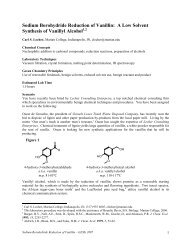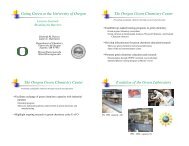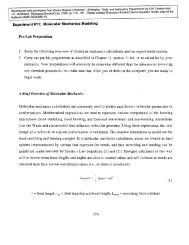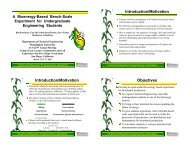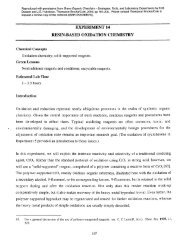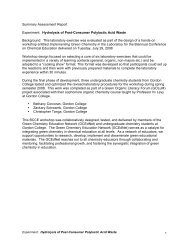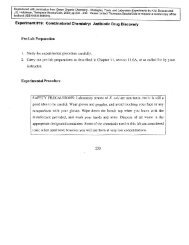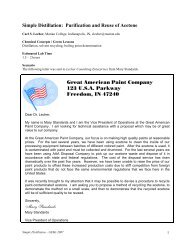Power Point Presentation (PDF) - Green Chemistry Center
Power Point Presentation (PDF) - Green Chemistry Center
Power Point Presentation (PDF) - Green Chemistry Center
Create successful ePaper yourself
Turn your PDF publications into a flip-book with our unique Google optimized e-Paper software.
Synthesis of Banana Oil<br />
Using <strong>Green</strong> <strong>Chemistry</strong><br />
Pamela Brown<br />
Simon Dexter<br />
New York City College of Technology<br />
Brooklyn, NY<br />
<strong>Green</strong> <strong>Chemistry</strong>: As American<br />
as Apple Pie<br />
As educators we have the opportunity<br />
to influence future generations of<br />
chemists<br />
The laboratory presented today was<br />
developed with an undergraduate,<br />
Simon Dexter, as an honors project in<br />
General <strong>Chemistry</strong> II.<br />
AAS in Chemical Technology<br />
Background<br />
General <strong>Chemistry</strong> I and II (8 credits)<br />
Organic Chemicstry I and II (10 credits)<br />
Analytical <strong>Chemistry</strong> I and II ( 9 credits)<br />
Introduction to Physical <strong>Chemistry</strong> (3 credits)<br />
Science Research Skills (3 credits)<br />
Physics I and II ( 8 credits)<br />
Pre-Calculus ( 4 credits)<br />
English I and II ( 6 credits)<br />
Psychology (3 credits)<br />
Liberal Arts Electives ( 6 credits)<br />
Synthesis of esters, especially 3-<br />
methylbutylacetate, banana oil, is a<br />
classic experiment performed in organic<br />
chemistry labs across the country.<br />
Traditionally, the Fisher esterification is<br />
performed:<br />
CH 3 CH 2 OH<br />
CH CH 2 +<br />
CH 3<br />
O<br />
OH<br />
C<br />
=<br />
CH 3<br />
CH CH 2 C CH 3 + H 2 O<br />
CH 3 CH 2 O<br />
isopentanol<br />
acid isopentyl acetate<br />
water<br />
3-methylbutanol + acetic acid= 3-methylbutylacetate+water<br />
CH 3<br />
O<br />
Eq. 1
Background<br />
The reaction uses sulfuric acid as catalyst and<br />
requires about one hour of reflux to reach<br />
equilibrium where:<br />
Keq = 4.2<br />
At equilibrium the yield is only about 67%.<br />
An ether, such as ethyl ether is added to extract the<br />
banana oil. The banana oil is recovered by<br />
fractional distillation.<br />
Microwave Induced Heating<br />
Microwave radiation rapidly heats<br />
polar substances.<br />
Polar substances try to align<br />
themselves with the electric field.<br />
Since the frequency is 2450 MHz the<br />
molecules don’t have time to line up<br />
one way before they have to line up<br />
the other way. The resulting friction<br />
causes the solution to heat up.<br />
3-Methylbutylacetate Synthesis with<br />
Microwave Heating<br />
Stoichiometric amounts of acetic anhydride (7.0<br />
mL=0.074 moles) and 3-methylbutanol (8.0 mL = 0.074<br />
moles) are mixed in an HP500 pressure vessel and<br />
heated in a CEM MARS Microwave oven with<br />
temperature control at ambient pressure for 8 minutes at<br />
110C, after a 2 minute ramp to the reaction temperature.<br />
3-methylbutylacetate + acetic anhydride= 3-methylbutylacetate +acetic acid<br />
CH<br />
CH 3 O<br />
3 CH<br />
CH CH 2 OH + C<br />
== CH 3 CH 2 O CH 3<br />
CH CH 2<br />
O<br />
C<br />
+<br />
CH CH 3<br />
3 C<br />
CH 3 O<br />
O<br />
OH<br />
O<br />
Determination of Yield<br />
The products are titrated using 2.0 M NaOH. The sample<br />
separates into 2 phases, an organic phase containing essentially<br />
pure 3-methylbutylacetate (average yield = 90%), and an<br />
aqueous phase containing sodium acetate. Titration results can<br />
be used to calculate the yield.<br />
Acetic Anhydride + water ! 2 Acetic acid<br />
Acetic Acid + NaOH ! Sodium acetate + water<br />
Moles 3-methylbutylacetate produced<br />
= 2X initial moles of acetic anhydride - moles of acetic acid in<br />
product<br />
= 2X initial moles of acetic anhydride - moles of NaOH to titrate<br />
product
Why is this an example of green chemistry?<br />
Eliminates the need for using sulfuric<br />
acid as a catalyst, and ether for the<br />
extraction<br />
Eliminates the need for fractional<br />
distillation<br />
Reduces energy consumption<br />
Additional Applications<br />
Last summer an undergraduate,<br />
Alyse Rich, supported by an NIH<br />
Bridges grant and a high school<br />
student, Vincent Ong, supported by<br />
an ACS SEED grant studied the rates<br />
of reaction using microwave heating<br />
and compared them to conventional<br />
heating.<br />
Reactions Studied<br />
3-methylbutanol + acetic anhydride _ 3-methylbutylacetate + acetic acid<br />
CH 3 CH 3 CH 3<br />
O<br />
CH 3 CH<br />
CH CH 2 OH C<br />
== CH 3 CH 2 O CH<br />
CH 2<br />
C<br />
CH 3<br />
O<br />
O<br />
CH 3<br />
+<br />
C<br />
O<br />
OH<br />
O<br />
ethanol + acetic anhydride _ ethylacetate + acetic acid<br />
CH 3 O<br />
CH 3 OH<br />
C<br />
CH<br />
+ ==<br />
3 O<br />
CH 2<br />
CH 3 O O<br />
C<br />
O CH 3<br />
CH 2 C<br />
+<br />
C<br />
CH 3<br />
OH<br />
O<br />
Determination of Rate Equation<br />
A! B<br />
First Order Reaction:-d[A]/dt = k[A]<br />
Plot of ln[A] vs t is a straight line,<br />
slope = -k<br />
Second Order Reaction –d[A]/dt =<br />
k[A] 2<br />
Plot of 1/[A] vs t is a straight line,<br />
slope = k
Procedure<br />
• Two equimolar samples of acetic anhydride and<br />
alcohol were prepared (~15 mL total volume)<br />
• One was heated for a given time and temperature<br />
(T=80, 90, 110C with 3-methylbutanol and T=70,<br />
75, 82C with ethanol) in a CEM Microwave reactor<br />
with temperature control. The second was heated in<br />
a constant temperature oil bath.<br />
• The % of unreacted acid = ROH and the % yield of<br />
ester was determined by titration.<br />
• Plots of % ROH vs time, ln (% ROH) vs time and<br />
% ROH -1 vs time were prepared to determine the<br />
reaction order, rate constant and activation energy<br />
Plot of 1/ % ROH vs Time at 80C for<br />
microwave heating – slope = k<br />
Figure 1- Banana oil synthesis- Microwave Heating - 80C<br />
2 min ramp to 80C = 0 time<br />
mL 2M NaOH time (min) % Yield time (min) 1/(% reactant)<br />
67.1 0.0123<br />
0 18.7 0<br />
71.6 0 6.5 0 0.010695<br />
74.5 0 -1.6 0 0.009843<br />
70.5 0.5 9.1 0.5 0.011001<br />
64.5 2 25.4 2 0.013405<br />
65.1 4 24.1 4 0.013175<br />
59.6 6 39 6 0.016393<br />
52.5 8 57.9 8 0.023753<br />
51.5 10 60.6 10 0.025381<br />
48.6 12 68.7 12 0.031949<br />
1/% reactant<br />
% Yield<br />
80<br />
70<br />
60<br />
50<br />
40<br />
30<br />
20<br />
10<br />
0<br />
-10<br />
0.035<br />
0.03<br />
0.025<br />
0.02<br />
0.015<br />
0.01<br />
0.005<br />
0<br />
1/%reactant vs time(min)-80C microwave<br />
0 5 10 15<br />
time (min)<br />
% Yield vs Time - Microwave Heating - 80C<br />
y = 0.0016x + 0.0099<br />
R 2 = 0.9315<br />
0 2 4 6 8 10 12 14<br />
Time (minutes)<br />
Arrhenius Equation: k = A exp (-E/RT)<br />
Plot of ln k vs 1/T for microwave heating- slope = -E/R<br />
Figure 5 - ln k vs 1/T(K) - banana oil synthesis - microwave heating<br />
k Temperature(C) 1/T(K) ln(k)<br />
0.0016 80 0.002833 -6.43775<br />
0.0042 100 0.002681 -5.47267<br />
0.0102 110 0.002611 -4.58537<br />
Experimental Activation Energies<br />
Reaction<br />
E a , Activation<br />
Energy (kJ/mole)<br />
A, Arrhenius<br />
Constant<br />
ln k<br />
0<br />
-1<br />
-2<br />
-3<br />
-4<br />
-5<br />
-6<br />
Determination of Activation Energy and Arrhenius<br />
Constant- Ln k vs 1/T(K)<br />
-7<br />
0.00255 0.0026 0.00265 0.0027 0.00275 0.0028 0.00285<br />
1/T(K)<br />
y = -8026.7x + 16.24<br />
R 2 = 0.9659<br />
Ethylacetate synthesis – conventional heating 185 2.3 x 10 24<br />
Ethylacetate synthesis – microwave heating 110 4.3 x 10 13<br />
Banana oil synthesis– microwave heating and<br />
conventional heating<br />
67 1.1 x 10 7
Discussion<br />
• With ethanol, the rate of reaction was 2-3<br />
times greater with microwave heating<br />
than conventional heating.<br />
• With 3-methylbutanol the rates were<br />
equal.<br />
• This suggests that the alignment of<br />
molecules due to the oscillating electric<br />
field produced by the microwaves may<br />
have a catalytic effect on smaller<br />
alcohols.<br />
Conclusion<br />
Introducing <strong>Green</strong> <strong>Chemistry</strong> Labs<br />
into the curriculum reduces waste<br />
generated by the college and creates<br />
a culture of respect for the<br />
environment<br />
Encouraging students to develop<br />
these labs is an opportunity to<br />
develop short-term student projects<br />
with tangible results




